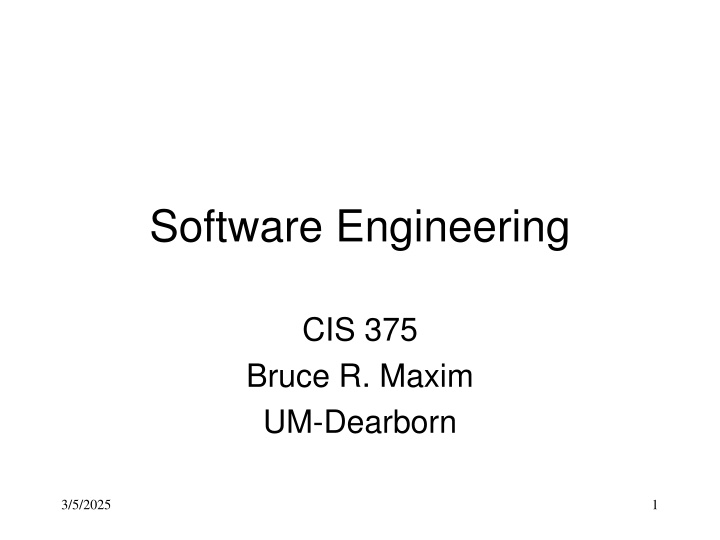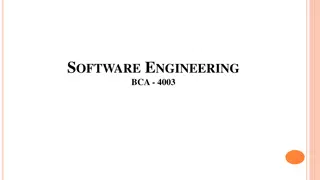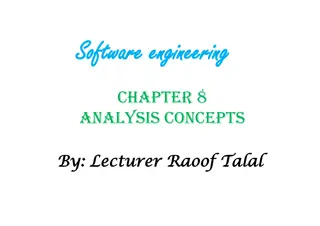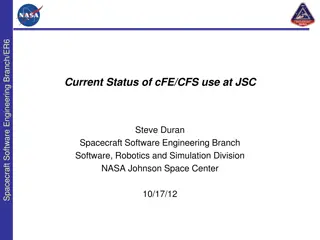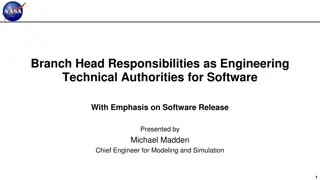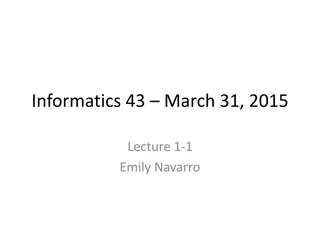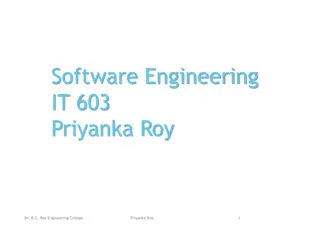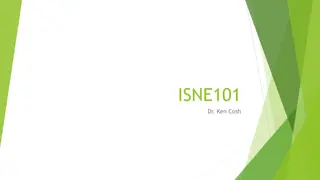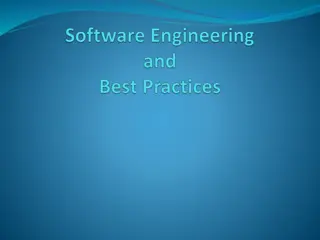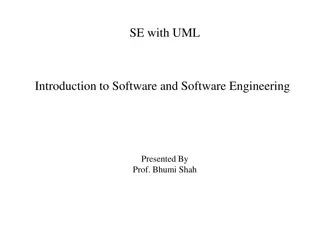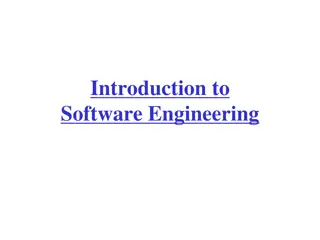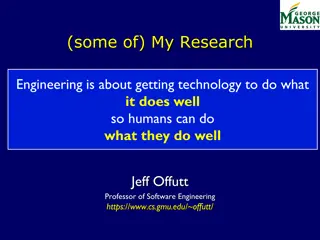Software Engineering
Software engineering plays a vital role in avoiding costly errors that can have severe consequences, as exemplified by past failures. It emphasizes project management, process improvement, object-oriented analysis and design, user interface design, testing, and validation to ensure software quality.
Uploaded on Mar 05, 2025 | 1 Views
Download Presentation

Please find below an Image/Link to download the presentation.
The content on the website is provided AS IS for your information and personal use only. It may not be sold, licensed, or shared on other websites without obtaining consent from the author.If you encounter any issues during the download, it is possible that the publisher has removed the file from their server.
You are allowed to download the files provided on this website for personal or commercial use, subject to the condition that they are used lawfully. All files are the property of their respective owners.
The content on the website is provided AS IS for your information and personal use only. It may not be sold, licensed, or shared on other websites without obtaining consent from the author.
E N D
Presentation Transcript
Software Engineering CIS 375 Bruce R. Maxim UM-Dearborn 3/5/2025 1
What is CIS 375 about? Project Management Process Improvement Object Oriented Analysis Object Oriented Design User Interface Design Testing and Validation 3/5/2025 2
Why is software engineering important? To avoid costly errors caused by software: Lost Voyager Spacecraft (one bad line of code caused failure) 3 Mile Island (poor user interface design) Several people killed by a radiation machine (no means of catching operator errors) Affordable Care Web Site (poor user interface and non-existent testing) 3/5/2025 3
Software Crisis Software failures receive a lot more publicity than software engineering success stories. The software crisis predicted thirty years ago has never materialized and software engineering successes now outnumber the failures. The problems that afflict software development are more likely to be associated with how to develop and support software properly, than with simply building software that functions correctly. 3/5/2025 4
Historical Project Cost Allocation 3/5/2025 5
Early Error Detection Saves Money 3/5/2025 6
Software Characteristics Software is both a product and a vehicle for developing a product. Software is engineered not manufactured. Software does not wear out, but it does deteriorate. Most software is still custom-built. 3/5/2025 7
Software Designer Characteristics Studies have found that many designers tend to suffer from the not invented here syndrome 80% of most software errors can be discovered by peer review (proof reading) the code or document 3/5/2025 8
Software Myths Part 1 Software standards provide software engineers with all the guidance they need. People with modern computers have all the software development tools they need Adding people is a good way to catch up when a project is behind schedule. Giving software projects to outside parties to develop solves software project management problems. 3/5/2025 9
Software Myths Part 2 A general statement of objectives from the customer is all that is needed to begin a software project. Project requirements change continually and change is easy to accommodate in the software design. Once a program is written, the software engineer's work is finished. 3/5/2025 10
Software Myths Part 3 There is no way to assess the quality of a piece of software until it is actually running on some machine. The only deliverable from a successful software project is the working program. Software engineering is all about the creation of large and unnecessary documentation not shorter development times or reduced costs. 3/5/2025 11
Software Engineering 1. A strategy for producing high quality software. 2. Software engineering encompasses a process, management techniques, technical methods, and the use of tools. 3/5/2025 12
What is high quality software? It must be useful (to the original customer). It must be portable (work at all of the customer s sites). It must be maintainable. It must be reliable. It must have integrity (produces correct results, with a high degree of accuracy). 3/5/2025 13
What is high quality software? It must be efficient. It must have consistency of function (it does what the user would, reasonably expect it to do). It must be accessible (to the user). It must have good human engineering (easy to learn and easy to use). 3/5/2025 14
Software Engineering Phases Definition phase focuses on what (information engineering, software project planning, requirements analysis). Development phase focuses on how (software design, code generation, software testing). Support phase focuses on change (corrective maintenance, adaptive maintenance, perfective maintenance, preventative maintenance). 3/5/2025 15
Software Life Cycle Phases 1. 2. 3. 4. 5. 6. 7. 8. 9. Requirements, analysis, and design phase. System design phase. Program design phase. Program implementation phase. Unit testing phase. Integration testing phase. System testing phase. System delivery. Maintenance. 3/5/2025 16
Umbrella Activities Part 1 Software project tracking and control (allows team to assess progress and take corrective action to maintain schedule) Risk management (assess risks that may affect project outcomes or quality) Software quality assurance (activities required to maintain software quality) Formal technical reviews (assess engineering work products to uncover and remove errors before they propagate to next activity) 3/5/2025 17
Umbrella Activities Part 2 Measurement (define and collect process, project, and product measures to assist team in delivering software meeting customer needs) Software configuration management (manage effects of change) Reusability management (defines criteria for work product reuse and establish mechanisms to achieve component reuse) Work product preparation and production (activities to create models, documents, logs, forms, lists, etc.) 3/5/2025 18
Waterfall Model Communication project init iat ion requirement gat hering Planning estimating scheduling tracking Modeling analysis design Construction code test Deployment delivery support f eedback 3/5/2025 19
Tower Game - Resources The mission of each team is to build a tower as high as possible using only what is placed in front of them. Each team can have 4 members. Material for each group: Two A4-size sheets of construction paper per team. One pair of scissors per team. Two 20-inch strips of clear tape per team. No other materials may be used. 3/5/2025 20
Tower Game - Rules The team engineering the tallest tower wins a prize. The tower must be freestanding and remain freestanding for at least 60 seconds. The tower cannot be taped to anything for support. You must build to your planned design If you change your design you must start over by revising your plan and get it approved. No testing will be allowed until you have shown your work and have a tower built to ready to test - for 60 seconds free standing NOTE You will have no more than 20-minutes if that. 3/5/2025 21
Why doesnt this approach work? Was it difficult to get the group to agree on what steps to take? Customers are not capable of describing their needs completely or precisely. Customers and developers like change the specifications as development proceeds 3/5/2025 22
Prototyping Model Quick plan Quick plan Communication communication Modeling Mode ling Quick de sign Quick design Deployment Deployment delivery & Delivery & Feedback feedback Construction of prototype Construction of prototype 3/5/2025 23
Prototyping in Practice concept definition implementation of a skeletal system user evaluation and concept refinement implementation of refined requirements user evaluation and concept refinement implementation of refined requirements This continues until times runs out or desired product quality and functionality is acheived 3/5/2025 24
Airplane Prototype Concept definition: Your team has 8 minutes to build an airplane capable of landing on a table Implement skeletal system: Your team designs its first plane and documents the design steps User evaluation: Test the plane s ability to fly and land on the table 3/5/2025 25
Refined Airplane Prototype Evaluate the test results: What would you change about the design document or air plane Implement skeletal system: Your team has 6 minutes to make one or more modifications to the first plane and documents the modified design steps User evaluation: Test each plane modification on the plane s ability to fly and land on the table 3/5/2025 26
Throw Away Prototype Evaluate the test results: What would you change about the design document or air plane Implement skeletal system: Your team has 6 minutes to create a different plane and document the modified design steps User evaluation: Test the new plane s ability to fly and land on the table 3/5/2025 27
Lessons Learned Was it helpful to record your design on paper before starting construction? Did you use text or drawings? How did you represent the procedural nature of the design (e.g. cuts vs folds)? How were the test results integrated into the new design? Would adding more or different types of materials change your design? How would you test this? Did you expect the first prototype to land properly? 3/5/2025 28
Spiral Model Compromise? planning estimation scheduling risk analysis communication modeling analysis design start deployment delivery feedback construction code test 3/5/2025 29
Comparing Process Models Part 1 Overall flow and level of interdependencies among tasks Degree to which work tasks are defined within each framework activity Degree to which work products are identified and required Manner in which quality assurance activities are applied Manner in which project tracking and control activities are applied 3/5/2025 30
Comparing Process Models Part 2 Overall degree of detail and rigor of process description Degree to which stakeholders are involved in the project Level of autonomy given to project team Degree to which team organization and roles are prescribed 3/5/2025 31
